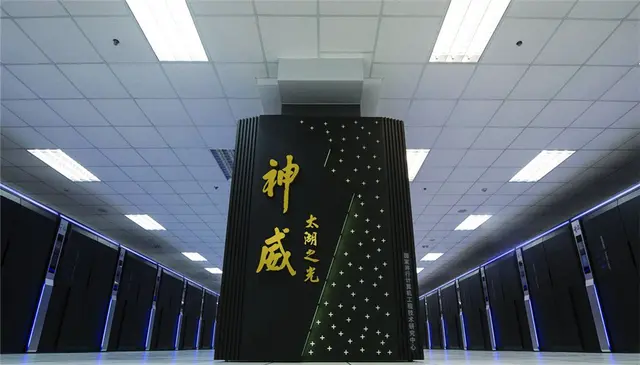China has bolstered its claim toleadership in the highest reaches of computingwith a supercomputer that was built with domestic processor chips.
A massive machine in the city of Wuxi grabbed the top spot in a twice-yearly ranking of the 500 fastest scientific computers, offering more than twice the performance of another Chinese system that has led the list for three years. The supercomputer’s test performance is roughly five times faster than the leading U.S. system, which now ranks third.
Sunway TaihuLight, as the new machine is called, marks the first time China has taken the top speed ranking without using U.S. semiconductor technology.
The prior No. 1 system used chips fromIntelCorp., which was prevented from sending chips to upgrade the system by a U.S. export ban last year.
In another sign of its heavy investments in the field, China for the first time placed more machines than the U.S. on the so-called Top500 list, by 167 to 165.
Both developments, expected to be announced at a supercomputer conference that opened in Germany, underscore the waning U.S. dominance of technology considered crucial for science and national defense. Supercomputers have long been used by governments for cracking codes and nuclear weapons development, as well as for civilian uses such as climate forecasting, oil exploration and auto design.
The U.S. Department of Energy allocated $525 million to help build three faster supercomputers at U.S. national labs. The U.S. Congress, meanwhile, is close to completing legislation designed to restore supercomputer leadership by 2023.
But the first U.S. system in the speed class of the Sunway TaihuLight won’t be operating until 2018, saidJack Dongarra,a University of Tennessee computer scientist.
China has “strongly pulled ahead in the race,” said Horst Simon, deputy director of the Lawrence Berkeley National Laboratory, a major supercomputer user that helps assemble the Top500 list. “The fact that every single piece is Chinese-made is huge.”
U.S. concerns about Chinese competition emerged in 2010, whena system called Tianhe-1 briefly grabbed first placeon the list.
A follow-on system called Tianhe-2, which became No. 1 in 2013, rated about 34 quadrillion calculations per second—petaflops in industry parlance—on a set of standard tests.
Sunway TaihuLight reached 93 petaflops on the same tests and has a theoretical top speed of 125.4 petaflops, Mr. Dongarra said.
The system emerges as China has been trying toreduce its reliance on U.S.-made chipsamidnational security concerns in both countries.
The Department of Commerce last year denied Intel’s request toexport chips to four centers associated with Tianhe-2, alleging links to “nuclear explosive activities.”
Chinese officialsdenied those chargesand have used locally made chips to upgrade the system.
Officials at National Research Center of Parallel Computer Engineering & Technology, which developed Sunway TaihuLight, told Mr. Dongarra the machine is expected to be used in fields such as manufacturing, life sciences, computer-aided engineering, weather forecasting and modeling other earth systems.
Its processors come from the Shanghai High Performance IC Center, a state-owned company founded in 2003 that also produced chips for a system called Sunway Bluelight that attracted attention in 2011.
Sunway TaihuLight, which is unusually energy-efficient as well as powerful, is a more significant accomplishment, Mr. Dongarra said.
The system comprises nearly 41,000 chips—each with 260 small calculating engines called processor cores—allowing designers to pack 10.65 million cores into 40 cabinets, he said.
That compares to about 560,000 cores in the fastest U.S. supercomputer.
Peter Ungaro,chief executive of Seattle-based computer makerCrayInc.,called it an impressive machine.
“We know that building a system of this size and complexity is no small task,” he said.
Wuxi, a city near Shanghai, is home to one of the country’s six supercomputing centers. It was funded by the so-called “863 program,” a central government plan to develop self-sufficiency in technologies deemed critical for national security and economic development.
The computer’s name is derived from that of a large freshwater lake that borders Wuxi. Sunway, which means “Divine Strength” or “Magical Strength,” also is a pun on the fact the chips inside them in Chinese are pronounced “Shenwei,” which means “Shanghai Strength” using an archaic term for Shanghai.
Intel, meanwhile, is using the conference in Frankfurt called ISC High Performance to unveil a new member of a chip line called Xeon Phi that is specifically designed for scientific calculations.
RivalNvidiaCorp.is introducing the Tesla P100, which is designed to accelerate computing chores in systems that also use Intel chips.
Both companies hope to benefit as scientists begin to use supercomputers for analytical tasks associated with a technique called deep learning, in addition to traditional jobs like simulating natural phenomena.
“We believe this dynamic will change how computers are created,” saidIan Buck,Nvidia’s vice president of accelerated computing.
(THE WALL STREET JOUNAL)
 简体中文
简体中文



